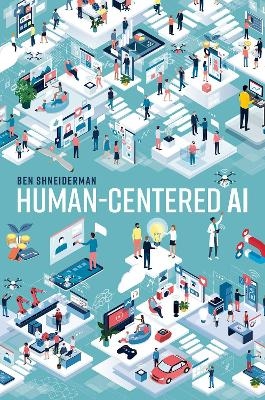
Human-Centered AI
Oxford University Press (Verlag)
978-0-19-284529-0 (ISBN)
The remarkable progress in algorithms for machine and deep learning have opened the doors to new opportunities, and some dark possibilities. However, a bright future awaits those who build on their working methods by including HCAI strategies of design and testing. As many technology companies and thought leaders have argued, the goal is not to replace people, but to empower them by making design choices that give humans control over technology.
In Human-Centered AI, Professor Ben Shneiderman offers an optimistic realist's guide to how artificial intelligence can be used to augment and enhance humans' lives. This project bridges the gap between ethical considerations and practical realities to offer a road map for successful, reliable systems. Digital cameras, communications services, and navigation apps are just the beginning. Shneiderman shows how future applications will support health and wellness, improve education, accelerate business, and connect people in reliable, safe, and trustworthy ways that respect human values, rights, justice, and dignity.
Ben Shneiderman is an emeritus distinguished university professor in the Department of Computer Science at the University of Maryland. His widely used contributions include clickable highlighted weblinks, high-precision touchscreen keyboards for mobile devices, and tagging for photos. Shneiderman's information visualization innovations include dynamic query sliders for Spotfire, development of treemaps for viewing hierarchical data, novel network visualizations for NodeXL, and event sequence analysis for electronic health records. Shneiderman is also the Founding Director (1983-2000) of the Human-Computer Interaction Laboratory, and a member of the UM Institute for Advanced Computer Studies (UMIACS) at the University of Maryland. He is a Fellow of the AAAS, ACM, IEEE, NAI, and the Visualization Academy and a Member of the US National Academy of Engineering, in recognition of his pioneering contributions to human-computer interaction and information visualization.
PART 1 WHAT IS HUMAN-CENTERED ARTIFICIAL INTELLIGENCE?
1: Introduction: High Expectations
2: How Do Rationalism and Empiricism Provide Sound Foundations?
3: Are People and Computers in the Same Category?
4: Will Automation, AI, and Robots Lead to Widespread Unemployment?
5: Summary and Skeptics Corner
PART 2 HUMAN-CENTERED AI FRAMEWORK
6: Introduction:Rising Above the Levels of Automation
7: Defining Reliable, Safe And Trustworthy Systems
8: Two-Dimensional HCAI Framework
9: Design Guidelines and Examples
10: Summary and Skeptic's Corner
PART 3 DESIGN METAPHORS
11: Introduction: What are the Goals of AI Research?
12: Science and Innovation Goals
13: Intelligent Agents and Supertools
14: Teammates and Tele-bots
15: Assured Autonomy and Control Centers
16: Social Robots and Active Appliances
17: Summary and Skeptic's Corner
PART 4 GOVERNANCE STRUCTURES
18: Introduction: How to Bridge the Gap from Ethics to Practice
19: Reliable Systems Based on Sound Software Engineering Practices
20: Safety Culture Through Business Management Strategies
21: Trustworthy Certification by Independent Oversight
22: Government Interventions and Regulations
23: Summary and Skeptic's Corner
PART 5 WHERE DO WE GO FROM HERE?
24: Introduction: Driving HCAI Forward
Chapter 25 Assessing Trustworthiness
26: Caring for and Learning from Older Adults
27: Summary and Skeptic's Corner
Personal Epilogue: How I Became Passionate about Human-Centered Approaches
Notes
Bibliography
Name Index
Subject Index
| Erscheinungsdatum | 20.01.2022 |
|---|---|
| Zusatzinfo | 26 colour illustrations |
| Verlagsort | Oxford |
| Sprache | englisch |
| Maße | 162 x 240 mm |
| Gewicht | 825 g |
| Themenwelt | Informatik ► Software Entwicklung ► User Interfaces (HCI) |
| Informatik ► Theorie / Studium ► Künstliche Intelligenz / Robotik | |
| Naturwissenschaften | |
| ISBN-10 | 0-19-284529-2 / 0192845292 |
| ISBN-13 | 978-0-19-284529-0 / 9780192845290 |
| Zustand | Neuware |
| Informationen gemäß Produktsicherheitsverordnung (GPSR) | |
| Haben Sie eine Frage zum Produkt? |
aus dem Bereich


